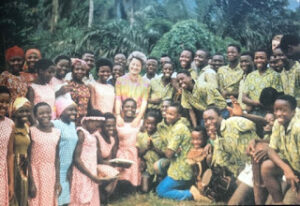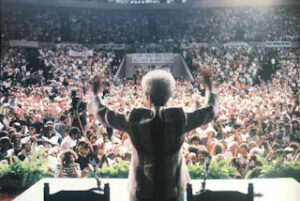Prayer in the charism of the Focolare Movement by Fr. Fabio Ciardi
 Third photo: Prayer for our brothers and sisters and the consequent union with God
Third photo: Prayer for our brothers and sisters and the consequent union with God
In a city there are real people, who must be loved, one by one.
To pray, Jesus asks us to enter the cell of our soul because that is where he dwells. But if He dwells in my inner cell, He also dwells in the cells of others. Here is a well-known text of Chiara’s, entitled “Look at all the flowers”, dated 6th November 1949:
“God who is in me, who has shaped my soul, who rests there in the Trinity (with the saints and the Angels), is also in the hearts of my brothers and sisters. It is not reasonable that I should love Him only in me. So my cell… my Heaven, is in me and just as it is in me it is in the souls of my brothers and sisters. And just as I love Him in me, recollecting myself in this Heaven – when I am alone – so I love Him in my brother or sister when they are near me.”
Our neighbour is not a distraction, but an opportunity for a new encounter with God.
Chiara was aware of this and in her prayers, she asked for a big heart in order to be able to love each person with the God’s love. In one of her most beautiful prayers she said:
“Lord, give me all the lonely… I have felt in my heart the passion that fills your heart for all
the forsakenness in which the whole world is drifting. I love every person that is sick and alone:
even plants in distress cause me pain… and animals left alone. Who consoles their weeping?
Who mourns their slow death? And who clasps to their own heart the heart in despair? Grant me,
my God, to be the tangible sacrament of your Love in this world, of your being Love: to be
your arms that clasp all the loneliness of the world and consume in love.” (Meditations)
We live within ourselves, so “living within” is an expression coined by Chiara, the fruit of her experience of and we live “outside ourselves”, another typical expression of Chiara. Prayer is living within and living outside (ourselves): it is a demanding dynamic, but perhaps this is the novelty of the prayer of the Focolare Movement.
The fruit of this movement is expressed in another well-known text:
“And so, when throughout the day the soul has willingly lost God in itself in order to be
transferred into God in its brother or sister (for each is equal to the other just as two flowers
in that garden are the work of an identical maker), and has done so out of love for Jesus
Forsaken who leaves God for God (and precisely God in self for the God present or being born
in the brother or sister…), when the soul returns to itself or better to the God within (because
alone in prayer or in meditation), it will find again the caress of the Spirit who – because he is
Love – is Love in truth, since God cannot fall short of his word and gives to the one who has given: he gives love to the one who has loved”. (Paradise’49, 6th November 1949)
In another writing she spoke more explicitly about her experience in this regard:
“When unity with our brothers and sisters is complete […] then, very often, I find You, Lord.
Going back into the temple of my soul, I meet you; or as soon as circumstances leave me
alone, you invite me, you draw me, gently but firmly, into your divine presence. Then you
alone reign within me and outside me, and the house you have given me to use for the
pilgrimage of life, feels to me as if it is, and I refer to it as, the dwelling place of my God.” (Meditations)
Chiara’s experience is that of a laywoman, it stems from a spirituality all focussed on communion-fellowship and shows the very close link between our relationship with God and our relationship with others, between prayer and action, between heaven and earth.
Where does inner unity come from? How can we pray always, while living/the constant gift of self
to others? To answer this question, Chiara would simply say: ‘By being Jesus: Jesus prayed constantly’ (24th December 1962).
For Chiara, prayer coincided with living God’s will, with living in love:
“By making everything an act of love for him, and maybe saying before each action,
especially when it is something important, “This is for you”, as one of the saints taught. “To
pray always” does not mean that we should multiply our prayers, but that we should direct
our heart and our entire life to God. We should study for him alone, work and exert every
effort, suffer, rest and even die, for him alone. And we should carry out every action as well as
we possibly can … all our actions are then transformed into sacred actions.”
(Family-Society Congress: “The Family centred on God is open to all humanity”, Castel Gandolfo,
8th April 1989)
Fourth photo: Prayer for the Ut omnes (That they may all be one)

Chiara’s is a vocation to be in the “highest contemplation”, and at the same time to be “immersed in the crowd”. Her way of prayer is the way of love towards all, to contribute to unity. We recall her discovery during the war, in the air raid shelters, of Jesus’ prayer to the Father for unity; the discovery that the vocation of the nascent Movement was the fulfilment of that unity desired by Jesus.
But if mutual love is the object of a command, unity is the object of a prayer. We can, we must love one another, so as to prepare for unity, but unity remains a gift to be asked for in prayer. So Chiara offered her voice so that Jesus could continue to address that prayer to the Father.
“We always repeated Jesus’ last prayer, his prayer for unity. It was our way of praying. We
believed that, after receiving Communion, Jesus would be within us. And, because we had
been taught that it is not we who receive him but he who receives us, we felt we were another
Christ and that we ought to lend him our voice so that he could repeat his last prayer, the
prayer for unity. We were imploring that unity should come about, and we can see now that it is on the way.” (Paradise ’49. Note 754 to the letter of 10th November 1949)
Jesus’ prayer becomes our prayer and our prayer becomes Jesus’ prayer. It should therefore be Jesus in us who prays. How? By letting Him in our midst be our prayer. This is Chiara’s characteristic way of praying. She spoke about it on 1st June 1958 in a conversation with a group of young people. She explained to them that at the beginning of the Movement, God:
“..could, for example, have raised up a group of people who spread Eucharistic piety far and
wide, or who spread the idea of adoring God. God is here on earth, so how can one not spend hours and hours, whole nights, adoring Jesus in the Eucharist? This is not what Jesus wanted from us”.
She then went on to give other examples, such as ‘concentrating on the inner life, “the interior castle” of our soul, then we would have been contemplatives. Jesus did not want this of us either”. So, what did Jesus want from the Focolare Movement?
“When he indicated God as the Ideal of our lives, we understood, “If you want to find him, you will find him in your midst. Love one another and by loving one another, I will be among you, for ‘Where two or more are united in my name, I am among them.’” So where can we find God? […] What is our vocation, our specific vocation in this century? It is to allow God to triumph in our midst.”(Cit. in J. Povilus – D. Falmi(ed.), Gesù in mezzo, Città Nuova, Rome 2019, p. 89)
The consequence of this way of praying is evident:
“What we have understood and what everyone understands when they meet the Ideal is that we must place mutual love at the basis of our life, at the basis of prayer, before prayer, because Jesus said, and the Father also said: before coming to me, be reconciled with your brother or sister, first you must have unity with your neighbours.” (Incisa Valdarno, 15th May 1987)
“Jesus in the midst” is essential for Chiara’s prayer. His presence is prayer. This overturns the image we usually have of union with God. We think of it as a tree whose root is union with God and its external expression is love of neighbour. We can also imagine the love of God as the fruit of the love of neighbour. Chiara affirmed,
“It is only by loving our neighbour that the little roots go deeper and the little stem shoots up to union with God.” (Castel Gandolfo, 25th February 1989)
And another time:
“We always give the example of the little plant. We say that the more the roots of the plant
sink into the ground, the higher the stem shoots up. Similarly, the more we deepen our love
for our neighbours, perhaps saying for you, for you, for you, for everyone we meet during the day, the more our union with God grows, and we feel it, we really feel it.” (Castel Gandolfo, 10th February 2002).
Can we live love for our brother or sister if we do not have love for God – prayer – within us?
Can we love the God we cannot see if we do not love the brother or sister we can see?
There is no dichotomy, but rather harmony, in a constant Trinitarian exchange, it is often challenging but it is necessary. With Jesus in our midst, who envelops us and enters deeply into us, who unites us to him personally and makes us all one.
https://fabiociardi.blogspot.com/2023/08/la-preghiera-nellesperienza-di-chiara.html


